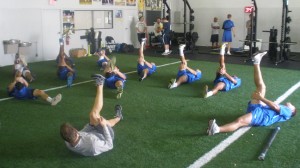By: Calum McLellan, CSCS, NASM-PESSports Performance SpecialistSpectrum Sports Performance It is commonly thought that if a little of something is good, then more must be better. When it comes to training for a sport, this couldn’t be further from the truth. Just like anything in life, training too frequently can lead to a syndrome known as overtraining. There are actually two types, over-reaching and overtraining.
It is commonly thought that if a little of something is good, then more must be better. When it comes to training for a sport, this couldn’t be further from the truth. Just like anything in life, training too frequently can lead to a syndrome known as overtraining. There are actually two types, over-reaching and overtraining.
Over-reaching is defined as:An accumulation of training and/or non-training stress resulting in short-term decrement in performance capacity with or without related physiological and psychological signs and symptoms of maladaptation in which restoration of performance capacity may take from several days to several weeks.
Over-reaching is actually a planned event that can be beneficial if handled carefully. Common uses of over-reaching are seen during the pre-season stages of many sports, where teams will hold multiple intense workouts a day a few weeks leading up to competition. The result of all of this training forces the body to make several adaptations to accommodate the stress and can yield great results. The problem with this strategy is keeping the volume of training precise enough to make change but not push them over the brink and injure them. Tracking how much work the athlete is doing and letting them recover enough from the training to actually make the desired adaptations is the difference between a successful over-reaching cycle and pushing the athlete to overtraining syndrome.
Overtraining Syndrome is defined as:An accumulation of training and/or non-training stress resulting in long-term decrement in performance capacity with or without related physiological and psychological signs and symptoms of maladaptation in which restoration of performance capacity may take several weeks or months.
Overtraining is where an athlete simply isn’t recovering as much as he is training. It is easy to forget that training is causing damage to the body and during the “recovery” time, which are all other hours spent outside of training. This is where employing recovery strategies such as proper nutrition/hydration and enough quality sleep is so vital to keeping the body from breaking down beyond the point of being able to repair fast enough.
The bottom line to preventing overtraining is monitoring the amount of training. This includes all time spend on the field/court/pavement during practice and competition. Using a structured periodized training program (including unloading/rest periods) is the best way to prevent overtraining. There are simple signs to monitor if you find that you or your young athlete are starting to become over trained, including:
Edited by Courtney VandeStreek
Leave a Reply